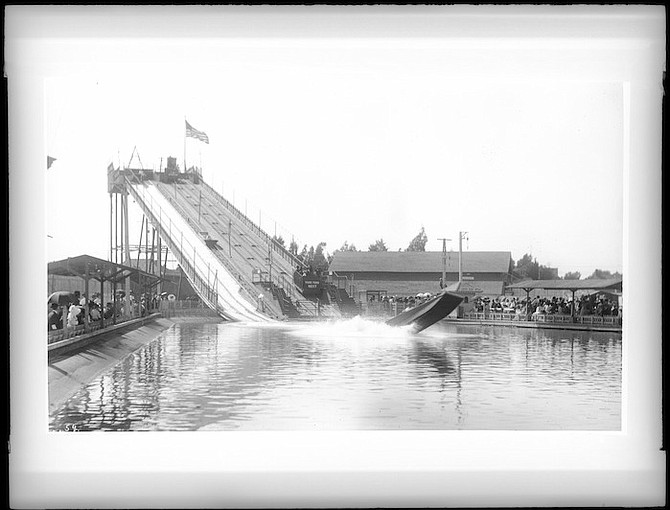 Facebook
Facebook
 X
X
 Instagram
Instagram
 TikTok
TikTok
 Youtube
Youtube

In January of 1907, the Venice Construction Company optioned from D.C. Collier's Ralston Realty 50 acres of land in a canyon on the northeast end of Adams Avenue overlooking Ward Road in Normal Heights.
Water parks were all the rage in Southern California at that time, and the Venice Construction Company, which owned and operated a profitable one in Los Angeles, was anxious to expand into San Diego County.
The company hired well-known landscape architect George Cooke to design Chutes Park, which called for damming a canyon and creating a lake overlooking Mission Valley. Around the lake the company would construct trails, bridges, and a grotto.
For some unknown reason, Venice Construction failed to live up to its plans. However, two months later, on March 14, 1907, the San Diego Evening Tribune reported that a new company, the San Diego Amusement Company, was doing the initial work of clearing brush, grading parking areas, and landscaping.
When completed, the Adams Avenue #11 Trolley line would be 100 feet from the entrance, which was to be built as an archway in East Indian style that would span the 80 feet of Adams Avenue. The plans and specifications called for "incandescent electric lights" (visible for miles) to illuminate the structure. Twenty-five men were clearing brush and hauling decomposed granite for the planned "roads, drives, paths, and walks," while the next step was to build a large pavilion.
Six months later, only the brush had been cleared, but Mr. W. L. Warner, a director of the San Diego Amusement Company, assured readers of the Evening Tribune that the project was on schedule. However, sometime between September 14 and October 10, 1907, Chutes Park was renamed Canyon Park and a contract awarded to local contractors Hughes and Keasley for construction of the entrance archway.
Work was completed on shrubbery covered rock pyramids, ten burros purchased for children to ride, a fence of 3000 feet begun, and water lines installed for the new landscaping; a scenic railroad and a roller coaster were promised attractions. Warner also acquired a wildcat for the zoo he planned to create. And then it all came apart.
"Gone With Coin and a Woman, Avers Wife," reported the January 25, 1908, issue of the San Diego Union. W. L. Warner left San Diego on the last train to Los Angeles — "The Owl" — on Saturday, January 18, 1908. He left behind a penniless wife and an unfinished Chutes/Canyon Park. He took with him the wife of another man and possibly $27,000. During his short but rather lucrative stay in San Diego, Warner spent $500, supplied by Mrs. Warner, on Chutes/Canyon Park.
What remained of this ill-fated enterprise languished until 1910, when the pool and fountain built for the water park were demolished as Normal Heights grew and space was needed for a bridge and the Adams Avenue car line to the new subdivision of Kensington Park.


In January of 1907, the Venice Construction Company optioned from D.C. Collier's Ralston Realty 50 acres of land in a canyon on the northeast end of Adams Avenue overlooking Ward Road in Normal Heights.
Water parks were all the rage in Southern California at that time, and the Venice Construction Company, which owned and operated a profitable one in Los Angeles, was anxious to expand into San Diego County.
The company hired well-known landscape architect George Cooke to design Chutes Park, which called for damming a canyon and creating a lake overlooking Mission Valley. Around the lake the company would construct trails, bridges, and a grotto.
For some unknown reason, Venice Construction failed to live up to its plans. However, two months later, on March 14, 1907, the San Diego Evening Tribune reported that a new company, the San Diego Amusement Company, was doing the initial work of clearing brush, grading parking areas, and landscaping.
When completed, the Adams Avenue #11 Trolley line would be 100 feet from the entrance, which was to be built as an archway in East Indian style that would span the 80 feet of Adams Avenue. The plans and specifications called for "incandescent electric lights" (visible for miles) to illuminate the structure. Twenty-five men were clearing brush and hauling decomposed granite for the planned "roads, drives, paths, and walks," while the next step was to build a large pavilion.
Six months later, only the brush had been cleared, but Mr. W. L. Warner, a director of the San Diego Amusement Company, assured readers of the Evening Tribune that the project was on schedule. However, sometime between September 14 and October 10, 1907, Chutes Park was renamed Canyon Park and a contract awarded to local contractors Hughes and Keasley for construction of the entrance archway.
Work was completed on shrubbery covered rock pyramids, ten burros purchased for children to ride, a fence of 3000 feet begun, and water lines installed for the new landscaping; a scenic railroad and a roller coaster were promised attractions. Warner also acquired a wildcat for the zoo he planned to create. And then it all came apart.
"Gone With Coin and a Woman, Avers Wife," reported the January 25, 1908, issue of the San Diego Union. W. L. Warner left San Diego on the last train to Los Angeles — "The Owl" — on Saturday, January 18, 1908. He left behind a penniless wife and an unfinished Chutes/Canyon Park. He took with him the wife of another man and possibly $27,000. During his short but rather lucrative stay in San Diego, Warner spent $500, supplied by Mrs. Warner, on Chutes/Canyon Park.
What remained of this ill-fated enterprise languished until 1910, when the pool and fountain built for the water park were demolished as Normal Heights grew and space was needed for a bridge and the Adams Avenue car line to the new subdivision of Kensington Park.
Comments